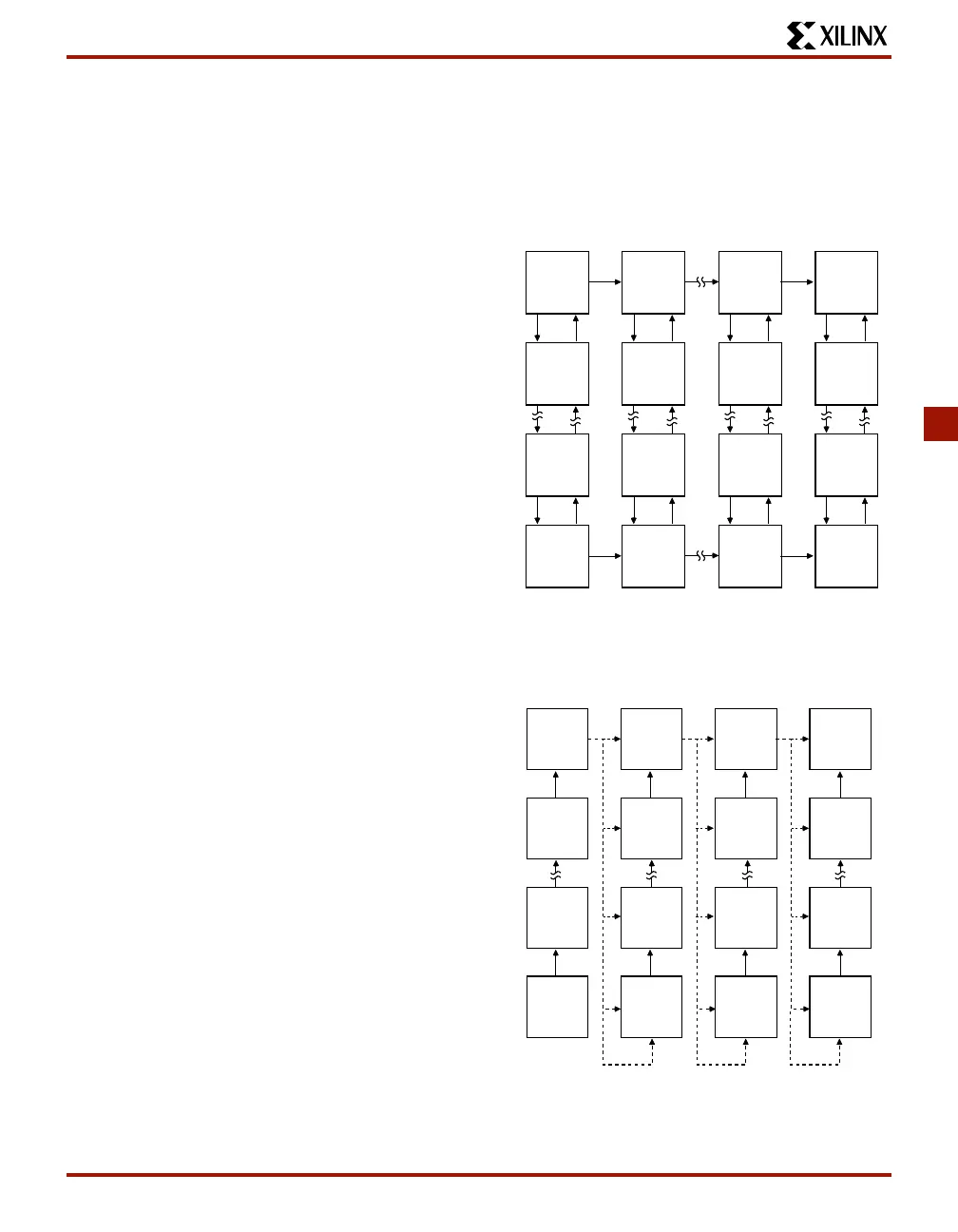September 18, 1996 (Version 1.04) 4-21
Fast Carry Logic
Each CLB F and G function generator contains dedicated
arithmetic logic for the fast generation of carry and borrow
signals. This extra output is passed on to the function gen-
erator in the adjacent CLB. The carry chain is independent
of normal routing resources.
Dedicated fast carry logic greatly increases the efficiency
and performance of adders, subtractors, accumulators,
comparators and counters. It also opens the door to many
new applications involving arithmetic operation, where the
previous generations of FPGAs were not fast enough or too
inefficient. High-speed address offset calculations in
microprocessor or graphics systems, and high-speed addi-
tion in digital signal processing are two typical applications.
The two 4-input function generators can be configured as a
2-bit adder with built-in hidden carry that can be expanded
to any length. This dedicated carry circuitry is so fast and
efficient that conventional speed-up methods like carry
generate/propagate are meaningless even at the 16-bit
level, and of marginal benefit at the 32-bit level.
This fast carry logic is one of the more significant features
of the XC4000 Series, speeding up arithmetic and counting
into the 70 MHz range.
The carry chain in XC4000E devices can run either up or
down. At the top and bottom of the columns where there
are no CLBs above and below, the carry is propagated to
the right. (See Figure 11.) In order to improve speed in the
high-capacity XC4000EX devices, which can potentially
have very long carry chains, the carry chain travels upward
only, as shown in Figure 12. This restriction should have lit-
tle impact, because the smallest XC4000EX device, the
XC4028EX, can accommodate a 64-bit carry chain in a sin-
gle column. Additionally, standard interconnect can be
used to route a carry signal in the downward direction.
Figure 13 on page 22 shows an XC4000E CLB with dedi-
cated fast carry logic. The carry logic in the XC4000EX is
similar, except that COUT exits at the top only, and the sig-
nal CINDOWN does not exist. As shown in Figure 13, the
carry logic shares operand and control inputs with the func-
tion generators. The carry outputs connect to the function
generators, where they are combined with the operands to
form the sums.
Figure 14 and Figure 15 on page 23 show the details of the
carry logic for the XC4000E and the XC4000EX respec-
tively. These diagrams show the contents of the box
labeled “CARRY LOGIC” in Figure 13. As shown, the
XC4000EX carry logic eliminated a multiplexer to reduce
delay on the pass-through carry chain. Additionally, the
multiplexer on the G4 path now has a memory-programma-
ble input, which permits G4 to directly connect to COUT.
G4 thus becomes an additional high-speed initialization
path for carry-in.
The dedicated carry logic is discussed in detail in Xilinx
document XAPP 013: “
Using the Dedicated Carry Logic in
XC4000
.” This discussion also applies to XC4000E
devices, and to XC4000EX devices when the minor logic
changes are taken into account.
The fast carry logic can be accessed by placing special
library symbols, or by using Xilinx Relationally Placed Mac-
ros (RPMs) that already include these symbols.
X6687
CLB CLB CLB CLB
CLB CLB CLB CLB
CLB
CLB
CLB
CLB
CLB
CLB
CLB
CLB
Figure 11: Available XC4000E Carry Propagation
Paths
X6610
CLB CLB CLB CLB
CLB CLB CLB CLB
CLB
CLB
CLB
CLB
CLB
CLB
CLB
CLB
Figure 12: Available XC4000EX Carry Propagation
Paths (dotted lines use general interconnect)

